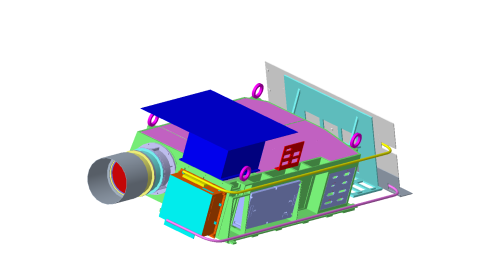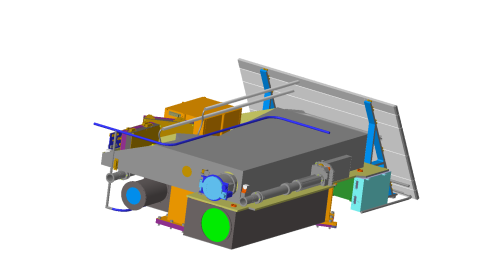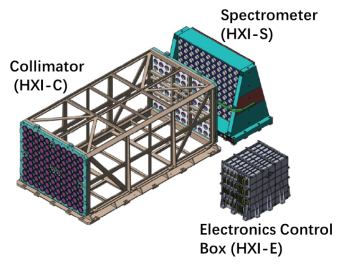Advanced Space-based Solar Observatory (ASO-S)

Advanced Space-based Solar Observatory (ASO-S for short) is my country's first comprehensive solar exploration satellite and one of the space science satellites deployed by the Chinese Academy of Sciences' strategic pilot science and technology special space science (Phase II). ASO-S is formally approved by the Chinese Academy of Sciences (CAS) under the Strategic Priority Research Program on Space Science in June 2017. At 07:43:55 Beijing time on October 9, 2022, the satellite is launched with the CZ-2D rocket. The nominal mission life is 4 years.
Solar flares and coronal mass ejections (CMEs) are two of the most powerful eruptive phenomena on the Sun. These eruptions are driven by evolution of the solar magnetic field. The ASO-S mission is uniquely designed to reveal connections among the solar magnetic field, solar flares, and CMEs. Its major scientific objectives therefore can be summarized as '1M2B', standing for the Magnetic field and the two kinds of Bursts (flares and CMEs). Via simultaneous observations of the global vector magnetic field, high-energy emission, and evolution of different layers of the solar atmosphere, the mission aims to achieve the following goals:
1) Simultaneous observations of solar flares and CMEs, two dominating eruptive events that regulate the space weather, to understand their connections and formation mechanisms.
Solar flares and CMEs are two prominent solar activities. Their occurrence frequency varies with the 11 year cycle of solar activity. Simultaneously observations of them play an essential role in revealing their connections and uncovering the underlying physical processes. The triggering mechanisms and evolution of solar flares and CMEs have been the frontier of solar physics research for several decades. Although flares are usually confined in a local area, CMEs can originate from both local and large scale structures. There is a good correlation between large flares and CMEs. It is still a matter of debate how the two eruptive events are related. Imaging observations of the source region of these two types of eruptions in white light, UV, X-ray, and ϒ-ray will enable us to follow these eruptions from the photosphere to the corona to better appreciate the relevant physical processes.
2) Observation of the full-disc vector magnetic field to uncover the build up of magnetic energy and its eruptive release during flares and CMEs and to see how the evolution of flares and CMEs are affected by the magnetic field.
A consensus has been reached that solar flares and CMEs are driven by evolution of the magnetic field, and the energy involved in these two eruptions comes from a gradual build-up of magnetic energy stored in the non-potential coronal magnetic field. It remains to be seen whether the energy build-up is dominated by shearing motion of the photosphere or by emergence of magnetic flux, and whether the CMEs are triggered by reconnection on small scales or MHD instabilities on large scales. One of the key issues in solar physics research is the relation between magnetic field configuration and characteristics of these eruptive events. The full-disk vector magnetograph onboard ASO-S will provide detailed information on the magnetic field evolution. HXI and LST are dedicated for flare and CME observations, respectively. Simultaneous observations of solar magnetic field, solar flares, and CMEs will help us to disentangle the relationships among them, and most importantly to establish quantitative relationships between the magnetic field and these eruptions. In particular, the evolution of small scale magnetic fields in the early phase of CMEs has been well-covered by past solar missions.
3) Observation of different layers of the solar atmosphere in response to eruptions to uncover the conversion and transport of different forms of energies.
Flares and CMEs can not only produce huge numbers of energetic electrons and ions, they can also induce plasma waves on a variety of scales and drive bulk motions of the background plasmas. These accelerated particles will propagate along the magnetic field lines. Some of them can penetrate into the low atmosphere and heat the plasma there producing high-energy emission at the same time. Others may escape into the interplanetary space and be observed as solar energetic particles. The X-ray and γ-ray observations of the ASO-S can reveal properties of accelerated electrons and ions and constrain their propagation in the solar atmosphere.
Furthermore, although the ASO-S is primarily a science mission, it has important application in monitoring destructive space weather events:
4) Observation of solar eruptions and the magnetic field evolution to facilitate forecasting of the space weather and to safeguard valuable assets in space.
Flares and CMEs can have tremendous impact on the space weather and may lead to devastating space environment. Flare observations by the ASO-S can be used to predict the arrival of damaging energetic particles at the Earth a few tens of minutes in advance. From the CME observations by the ASO-S, we can determine their morphology and propagation direction, then predict the arrival of a CME at the Earth tens of hours or a few days in advance. A good understanding of the relationship between the magnetic field configuration and the eruptions can lead to much advanced space weather forecast based on magnetic field observations of the ASO-S.
The proposed ASO-S mission has three payloads onboard, i.e., the Full-disk Vector MagnetoGraph, the Lyman-alpha Solar Telescope and the Hard X-ray Imager.
Full-Disc Vector Magnetograph (FMG)

The Full-disk vector MagnetoGraph (FMG) measures the magnetic fields of the photosphere over the entire solar disk. FMG consists of an imaging optical system, a polarization optical system, and a image acquisition and processing system. The telescope is a telecentric optical design with 140 mm aperture, and the detector is a CMOS camera with 4k by 4k array and 16 fps. The polarization optical system consists of a traditional Lyot-type birefringent and innovational LCVR-type polarimeter. The birefringent filter works in the Fraunhofer line Fe I 532.4 nm with FWHM 0.011 nm.
In order to get higher accuracy, FMG uses multi-frame add mode (deep-integration mode). In normal mode of observation, 256 frames (half for left and half for right) will be collected for one magnetogram. That means within 32s (for obtaining 256 frames) the pointing should be stabilized at least within half pixel, say 0.25". Thus, FMG has itself tip/tilt system. In deep-integration mode, the sensitivities are 5G and 150G for longitudinal and transverse component, respectively.
Compared with the Hinode/SP, a famous payload for the measurement of solar magnetic field, FMG has a much larger field of view and higher time cadence. Comparing to the magnetographs onboard SDO/HMI and SOHO/MDI, FMG has a simpler observation mode and a higher measurement precision.
Lyman-alpha Solar Telescope (LST)

The Lyman-alpha Solar Telescope (LST) is composed of a Solar Disk Imager (SDI) with an aperture of 60 mm, a Solar Corona Imager (SCI) also with an aperture of 60 mm, a White-light Solar Telescope (WST) with an aperture of 130mm, and two Guide Telescopes (GTs).
The SDI is to image the Sun from the disk center to 1.2 solar radii in the Lyman–alpha waveband (121.6±4.5 nm) with a cadence of 4 – 40 s. The SDI uses a 4608 by 4608 camera as the detector so as to guarantee the resolution of 1.2". A piezoelectric image stabilization system is adopted for both the SDI and the SCI to achieve the high spatial resolution.
The SCI uses a 2048 by 2048 camera to image the inner solar corona from 1.1 to 2.5 solar radii with a cadence of 3 – 60 s in both the Lyman-alpha waveband (122.6±3 nm) and white-light (700±32 nm). A beam-splitter divides the coming coronal light into two beams: the reflected beam feeds the Lyman-alpha channel while the transmitted beam feeds the white-light channel. The Lyman-alpha channel consists of a Lyman-alpha filter and a detector; the white-light channel consists of a broadband filter centered at 700 nm, linear polarizers and a detector. Three linear polarizer orientations (0, ±60°) are used to conduct the polarization measurement in the white-light waveband.
The WST is designed to image the Sun in violet narrow-band continuum (360±2.0 nm) from the disk center to 1.2 solar radii with a cadence of 1 – 120 s (it can be as high as 0.2 s in the burst mode). A 4608 by 4608 CMOS sensor is selected to be the detector, which allows a windowed observation mode with higher time cadence in the burst mode.
The guide telescopes work in 570 nm waveband. To guide, quadrant photodiode detectors are used to monitor the solar limb, calculate the displacement and produce the guiding signal, which is converted to triggering signals to the PZT actuators installed behind the main mirrors of both SCI and SDI. The GTs together with the PZT actuators and relevant electronics forms the image stabilizing system.
Hard X-ray Imager(HXI)

The Hard X-ray Imager (HXI) aims to image solar flares in hard X-rays from ~15-300 keV with an angular resolution of 3.1 arcseconds, field of view of 40 arcminutes, energy resolution (22% @ 32 keV), high time cadence (as high as 0.125 s). Since ASO-S has two other optical payloads, HXI adopts the similar principle used by the Hard X-ray Telescope (HXT) onboard the Japanese YOHKOH satellite and the Spectrometer Telescope for Imaging X-rays (STIX) for the Solar Orbiter mission, i.e., using indirect imaging technique via spatial modulation. This is different from the Reuven Ramaty High Energy Solar Spectroscopic Imager (RHESSI) that images the Sun with the indirect imaging technique via rotational modulation.
HXI is a high-precision imaging instrument. We made in total over 3400 slices of tungsten grid layers, which are stacked to produce 91 pairs of tungsten grids. These grids are installed in the front and rear base boards at the ends of the 1.2-meter-long collimator, forming 91 subcollimators. The HXR signals through them are recorded by 91 detectors behind and used to reconstruct images on the ground by several imaging algorithms. Besides, there are three detectors that monitor total fluxes, and another five that monitor the background fluxes. The detector array contains 99 LaBr3 detectors.
A solar aspect system is implemented with HXI to monitor the Sun in white-light, which provides pointing information of HXI with an accuracy better than 0.3 arcsec and locates eruptions on the Sun. The data is also used to correct blurry image caused by the pointing changes. Meanwhile, the SAS also monitors the deformation of the base boards at a level of microns and the relative twist at a level of arcseconds.
Data Access:https://aso-s.nssdc.ac.cn/